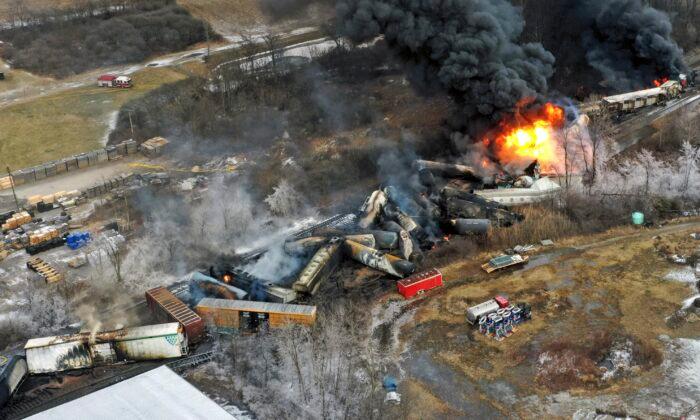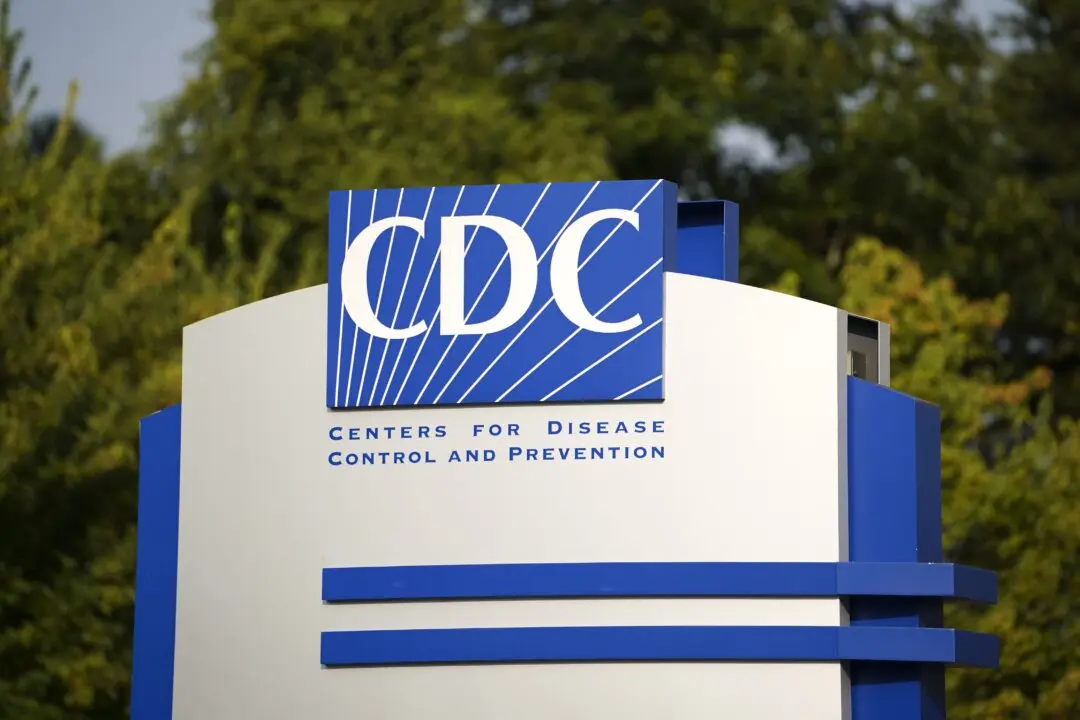Ohio has filed a 58-count civil lawsuit against Norfolk Southern Railway in federal court over the Feb. 3 toxic chemical derailment in East Palestine, state Attorney General Dave Yost said on March 14, citing his concern that the rail company’s accident rate has increased 80 percent over the past 10 years.
Norfolk Southern violated numerous state and federal laws, caused the release of “over 1 million gallons of hazardous chemicals” and created “hidden dangers” for the health of residents and Ohio’s natural resources, Yost said during an online news conference.
“Ohio shouldn’t have to bear the tremendous financial burden of Norfolk Southern’s glaring negligence. The fallout from this highly preventable incident may continue for years to come, and there’s still so much we don’t know about the long-term effects on our air, water, and soil.
“This was an epic disaster,“ he said. ”The cleanup is going to be expensive, and it is going to take some significant dollars to put the people of East Palestine back as close as possible to the position they were on Feb. 3.”

Derailment Background
On Feb. 3, a 151-car freight train operated by Norfolk Southern carrying derailed in East Palestine, a village of 4,761 residents in eastern Ohio that’s about a mile from the Pennsylvania border.When the train crashed, 38 rail cars derailed. A fire ensued, damaging an additional 12 cars.
Of the 20 cars carrying hazardous materials, 11 derailed, according to the National Transportation Safety Board.
After the Feb. 3 crash and subsequent fire, residents were ordered to evacuate because 11 of the burning cars were carrying hazardous materials, including vinyl chloride, which is a chemical used to make PVC pipes and other products. The National Cancer Institute notes that vinyl chloride has been linked to cancers of the brain, lungs, blood, lymphatic system, and liver.
Fearing a major explosion, authorities decided to release and burn the vinyl chloride from five cars on Feb. 6, sending a massive cloud of black smoke into the sky that could be seen for miles.
Hazardous Pollutants
The lawsuit asserts that the derailment and subsequent burning of toxic chemicals led to the release of an unknown volume of hazardous pollutants into the air, water, and ground, which has caused significant long-term threats to humans and the environment.Pollutants from at least 39 rail cars have spilled into Sulfur Run, Leslie Run, Bull Creek, North Fork Little Beaver Creek, Little Beaver Creek, the Ohio River, and still unknown waterways, Yost said.
He added that the disaster “has caused substantial damage to the regional economy of the state of Ohio, its citizens, and its businesses. The citizens of the region have been displaced, their lives interrupted, and their businesses shuttered.”

Ohio is entitled to recover lost taxes and other economic losses it has suffered from the crash and the aftermath, Yost stated.
The lawsuit seeks a declaratory judgment holding Norfolk Southern responsible for the recovery of costs and damages under both emergency response and common law, civil penalties under state environmental laws, and repayment of court costs among other requests.
Yost has asked the court to require that Norfolk Southern conduct future groundwater and soil monitoring at the derailment location, the surrounding areas, and beyond and to submit a closure plan to the Ohio Environmental Protection Agency.
‘Make It Right’
On March 13, DeWine’s office reported that around 6 million gallons of toxic water and 3,000 tons of contaminated soil have been removed from the derailment area.At the press conference, Yost said that he met with railroad representatives on March 13 and they were cooperative and recognize the railway’s responsibility in the disaster.
“The company has repeatedly said that it wants to make it right,” Yost said about Norfolk Southern. “Our lawsuit is designed to make sure that they keep their promise.”
During a March 9 U.S. Senate hearing about the derailment and railroad safety, Norfolk Southern CEO Alan Shaw apologized multiple times for the disaster while repeatedly defending the railroad’s safety record.
The National Transportation Safety Board (NTSB) and the Federal Railroad Administration (FRA) have launched investigations into that safety record.
Earlier this month, Norfolk Southern released a six-point safety plan.
At the hearing, Shaw conceded that “the safety mechanisms in place were not enough” to prevent the Feb. 3 derailment.
“We currently spend $1 billion a year on technologies, equipment, and infrastructure to enhance safety,” Shaw said.
“But the safety mechanisms in place did not prevent this accident, so we are focused on learning from this incident and working with industry to make changes.”
At the hearing, Sen. Ed Markey (D-Mass.) asked Shaw if Norfolk Southern completed $3.4 billion in stock buybacks and made $3.3 billion in profits last year. Shaw confirmed that those numbers are accurate.
“Sir, last year, we invested over a billion dollars in safety. And last year our number of accidents was the lowest it had been in the last 10 years,” Shaw told Markey.
“Our safety stats, senator, continue to improve, and I am committed to making Norfolk Southern’s safety culture the best in the industry.”
Markey replied, “You’re not having a good month. It seems like every week, there’s another accident that Norfolk Southern is a part of in our country.
“And what I’m hearing from you is just this great confidence that you have in your system. But I’ll tell you this was to show overconfidence breeds complacency and complacency breeds disaster.”

Railroad Safety Record
Since December 2021, the NTSB has assigned investigative teams to five Norfolk Southern incidents, the agency reported.Federal data indicates that Norfolk Southern trains are involved in around 260 accidents per year, which is one of the highest numbers among railroads.
Norfolk Southern has reported 3,397 events that could be classified as derailments over the past 20 years, Texas-based attorney Mikal Watts said.
In 2022, Norfolk Southern had 770 train car derailments involving hazardous materials compared to 79 incidents in 2012, Watts added.
According to a 10-year safety summary from the FRA, Norfolk Southern had an annual average of 163.6 derailments and 2.9 hazardous material releases.
Yost noted two more statistics that contributed to filing the legal action.
Norfolk Southern’s accident rate has surged 80 percent in the past 10 years, and at least 20 of the railroad’s derailments since 2015 have involved chemical releases, according to the lawsuit.
“The derailment was entirely avoidable,” Yost said, backing a position stated by the NTSB. “And I’m concerned that Norfolk Southern may be putting profits for their own company above the health and safety of the communities they operate in.”





